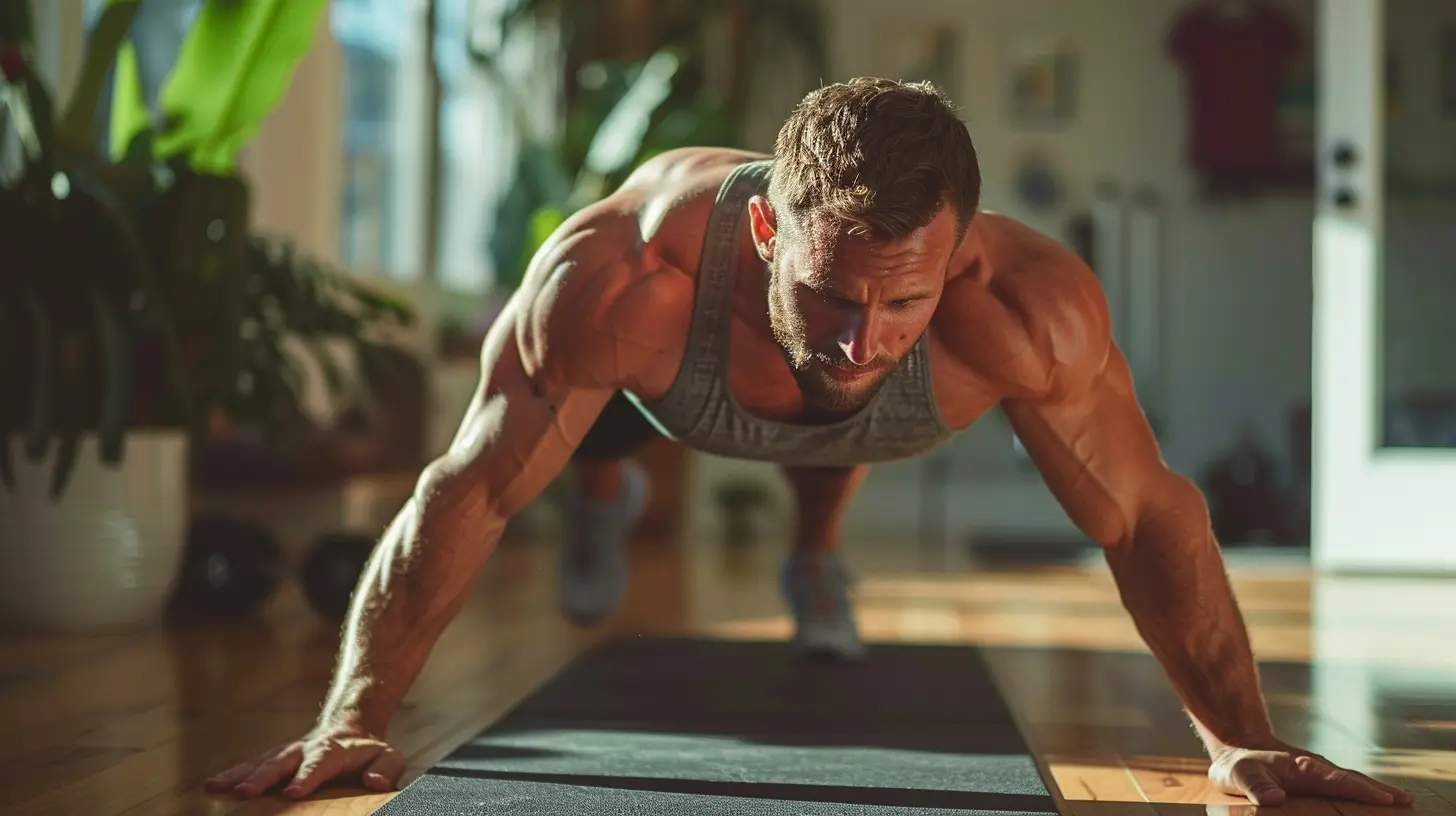
Newsletter Subscribe
Enter your email address below and subscribe to our newsletter

Enter your email address below and subscribe to our newsletter

Are you looking for a convenient and effective way to stay fit without the gym membership fees or bulky equipment? In today’s fast-paced world, finding time to work out can be a challenge. However, incorporating bodyweight exercises into your routine can be a game-changer. Join us as we dive into the realm of bodyweight workouts and discover how you can create a full-body workout that fits seamlessly into your busy schedule. Get ready to sculpt your body, boost your strength, and elevate your fitness level with just your own body as the ultimate tool.
In today’s fast-paced world, finding time to exercise can be a challenge. However, incorporating bodyweight exercises into your routine can provide numerous benefits that make working out more practical and effective. Let’s delve into the advantages of bodyweight exercises:
By incorporating bodyweight exercises into your fitness routine, you can enjoy the convenience, affordability, and effectiveness of this versatile workout approach. Whether you’re a busy professional, a fitness enthusiast on a budget, or someone looking to enhance their overall strength and flexibility, bodyweight exercises offer a practical and sustainable solution to staying active and healthy.
When it comes to maintaining a strong, healthy body, incorporating key bodyweight exercises into your workout routine is essential. These exercises utilize your own body weight as resistance, helping you build strength, improve endurance, and increase flexibility without the need for any equipment. Let’s delve into some of the most crucial bodyweight exercises and why they should be a staple in your fitness regimen.
Push-ups are a classic bodyweight exercise that targets multiple muscle groups, including the chest, shoulders, triceps, and core. They are a fantastic way to build upper body strength and improve overall muscle definition. Here are some key benefits of incorporating push-ups into your routine:
Squats are a fundamental bodyweight exercise that primarily targets the quadriceps, hamstrings, and glutes. They are incredibly effective for building lower body strength and improving functional movement patterns. Here’s why squats are an essential exercise:
Planks are a core-strengthening exercise that engages the abdominal muscles, lower back, and shoulders. They are crucial for developing a strong core, which is essential for proper posture and preventing back pain. Consider the following benefits of including planks in your routine:
Lunges are a dynamic bodyweight exercise that targets the quadriceps, hamstrings, glutes, and calves. They help improve lower body strength, balance, and flexibility. Let’s explore the importance of lunges in your workout routine:
Burpees are a full-body exercise that combines elements of strength training and cardiovascular conditioning. They work multiple muscle groups simultaneously and elevate your heart rate, making them a great addition to any HIIT (High-Intensity Interval Training) routine. Here’s why burpees are a valuable exercise:
Incorporating these key bodyweight exercises into your workout routine can help you achieve a well-rounded fitness level. Whether you’re a beginner or a seasoned fitness enthusiast, mastering these fundamental exercises will set a solid foundation for your overall strength and endurance. So, lace up your sneakers, clear some space, and start reaping the benefits of these essential bodyweight exercises today!

When it comes to designing a full-body workout, incorporating bodyweight exercises can be an effective way to build strength, improve endurance, and enhance overall fitness. By strategically structuring your routine with the right exercises, sets, repetitions, and rest intervals, you can create a balanced workout that targets all major muscle groups. Let’s dive into how you can design a full-body workout using bodyweight exercises for optimal results.
Selecting the appropriate bodyweight exercises is crucial to ensure that you target all muscle groups effectively. Here are some key exercises to consider for a well-rounded full-body workout:
Here’s an example of a bodyweight full-body workout routine:
Incorporating bodyweight exercises into your routine offers several benefits:
By following these guidelines and customizing your workout to suit your fitness level and goals, you can design an effective full-body routine using bodyweight exercises. Remember to focus on proper form, consistency, and progression to achieve optimal results.
Bodyweight training is a versatile and effective way to improve strength, flexibility, and overall fitness. Progression and modifications play a crucial role in maximizing the benefits of bodyweight exercises, helping individuals avoid plateaus and adapt their workouts to their fitness levels. In this blog section, we will delve into the various methods of progression, incorporating variations, and adjusting exercises to cater to different fitness levels.
By understanding the importance of progression and modifications in bodyweight training, individuals can continuously challenge themselves, avoid stagnation, and tailor their workouts to their specific fitness levels. Experimenting with different variations and adjustments can lead to improved performance and overall fitness gains over time.
In summary, this blog post highlighted the advantages of bodyweight exercises, recommended essential exercises for a comprehensive workout, gave insights on structuring a routine, and shared advice on advancing and adapting the workout. Embracing bodyweight exercises can enhance the versatility and efficacy of your fitness routine.
Incorporating bodyweight exercises into a workout routine has several benefits. These exercises are effective in improving strength, flexibility, and endurance. They can be done anywhere, making them accessible for people with limited equipment or space. Bodyweight exercises also help improve balance and coordination. Additionally, they can be modified to suit different fitness levels, making them suitable for beginners to advanced individuals.
Bodyweight exercises can be suitable for all fitness levels. They can be modified to accommodate beginners through advanced fitness levels by adjusting the intensity, difficulty, and volume of the exercises. Beginners may start with simpler variations and gradually progress to more challenging movements as they become stronger and more confident. However, individuals with specific health conditions or limitations should consult with a healthcare provider or fitness professional before starting any new exercise routine.
Yes, bodyweight exercises can be an effective alternative to using gym equipment for building muscle and strength. Exercises like push-ups, squats, lunges, and planks can challenge your muscles and help you build strength without the need for weights or machines. By adjusting the intensity and volume of bodyweight exercises, you can effectively target different muscle groups and achieve your fitness goals. Additionally, bodyweight exercises can improve balance, flexibility, and overall functional strength.
Beginners can start incorporating bodyweight exercises into their fitness regimen by selecting a few basic exercises such as push-ups, squats, lunges, planks, and jumping jacks. It is important to start with proper form to avoid injury. Beginners can gradually increase the number of repetitions or duration of holds as they build strength and endurance. Watching online tutorials, following workout apps, or working with a certified fitness trainer can also provide guidance and structure for incorporating bodyweight exercises effectively.
To progress in bodyweight exercises and continue challenging yourself, you can increase the difficulty in various ways. Some effective methods include increasing the number of repetitions, changing the tempo of the exercises (such as slowing down the movement), adding variations or progressions to the exercises (like doing one-arm push-ups instead of regular push-ups), incorporating isometric holds, or trying more advanced bodyweight exercises. Additionally, you can adjust your workout routine by increasing the number of sets or decreasing rest time between sets to make the workout more challenging. Remember to always maintain proper form to prevent injury and maximize the effectiveness of your bodyweight exercises.
Some key bodyweight exercises that target different muscle groups in a full body workout include:
Incorporating a variety of these exercises into a routine can provide a comprehensive full body workout without the need for equipment.
It is generally recommended to perform a full body workout with bodyweight exercises two to three times per week. This allows for adequate rest and recovery while still providing sufficient stimulus for muscle growth and overall fitness improvement.
Comments are closed.
I found the tips on modifying exercises for different fitness levels very helpful. It allows for scalability and makes the workout accessible to a wider range of people.
This article provided a comprehensive guide on creating a full body workout using bodyweight exercises. I appreciate the clear instructions and exercise examples.
I would have liked to see more emphasis on warm-up and cool-down routines to complement the workout. Overall, great content and informative for bodyweight enthusiasts.